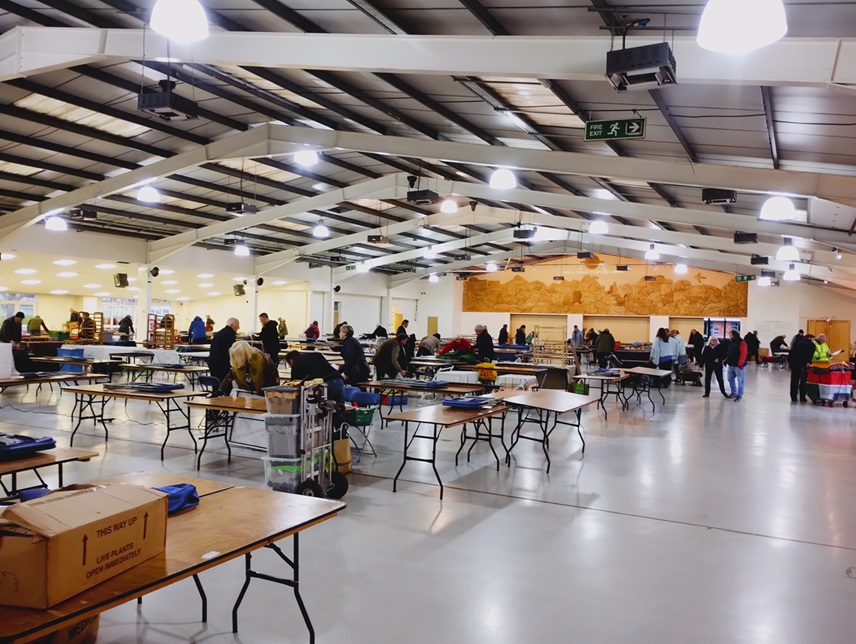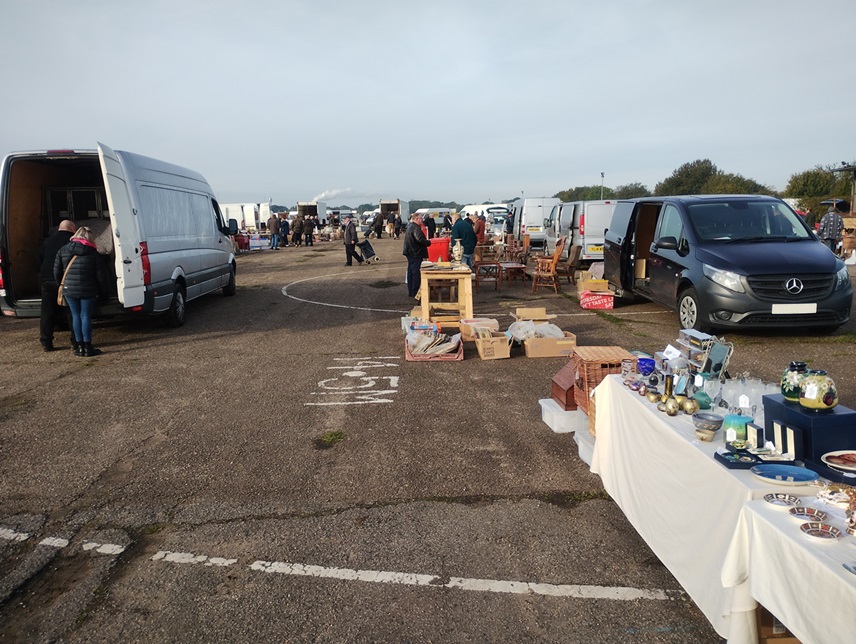This is part two of my Beginners Guide to Selling at an Antiques Fair. In the closing section of the first part, I discussed how to choose a fair that might suit you and your stock, so hopefully by this stage you’ve done that. Now comes the fun part, attending the fair and making some money.
Opening times
If you’ve read the relevant “instructions to sellers” for the fair you’re going to, you may well have been surprised by how early you have to get up. Selling antiques isn’t a business for people who have trouble getting out of bed in the morning and even if you are an early riser you’ll probably need some coffee along the way.
A typical antiques fair will open to the public at 09:00 a.m. For many people, that’s quite early on a weekend morning, but most traders will have been up for three or four hours by then.
You’ll probably have seen something like “early entry for trade” mentioned. In reality anyone can go in at that time but you typically pay a bit more. This a real world example of the saying “The early bird catches the worm”. In other words, the first buyers get the best bargains. I enjoy the early entry as the fair will be quieter and so, as a buyer, you can get round more quickly. You also have a better chance of being able to get back for an item before it’s sold.
There’s another, less obvious, benefit to getting in early. Traders like a fast start. There’s nothing like a couple of early sales to get your day going. As a buyer, if you ask about something in the first half an hour of a fair, traders will often settle quickly, and at a good discount, just to get money flowing.
Returning to our fair that opens at 09:00, we probably have a trade opening at 08:00. Some traders will need at least an hour and half to get set up, requiring the doors be open for set up at 06:30. Now, if you think you can set up more quickly you don’t need to be there at that time but, for a first go, you don’t want to be too much later. It also depends on the type of fair and the type of pitch you have. We’ll come to that next, but for now you’re probably queuing at 06:30 to get in.
What type of fair, what type of pitch?
Some fairs are both indoor and outdoor depending on the pitch you rent, some are indoor only, some are outdoor only. Some pitches must be pre-booked, some are paid for and allocated on arrival.
Typically indoor pitches must be pre-booked and when you arrive your name is on it. Obviously for these you have less of a rush to be there early to set up because you know you have your space assigned. In general, for indoor space you have to park outside and carry your stock from your vehicle. However, at some events, typically where large sheds are available, you may be able to bring your vehicle inside and sell directly from adjacent to it. You will still have a tightly allocated space though as these pitches tend to be very popular.
Outdoor pitches may be pre-booked or simply allocated when you arrive. In the latter case, getting in the queue early is important as the better pitches are handed out first. At big events (some of the outdoor events are massive) being at a distant pitch can be a huge disadvantage because many buyers will simply give up before they get to you. The problem with a pre-booked pitch is you have committed to going and if the weather turns wet, you lose your money, your stock gets wet or you have to give up some space in your vehicle for some sort of weather-proof covering.
Where did you sleep last night?
Probably the thing that amazed me most, indeed still amazes me most, about the antiques business is that in order to get the best pitch at outdoor events, a significant number of traders will arrive the night before a fair to start queuing. You might think getting in line at 06:00 for 06:30 gates opening is enthusiastic, but actually, many of the vehicles in front of you will have been there all night. The traders simply sleep in their vehicles. To quote the IACF Newark Runway instructions to traders “You may enter the Runway from 6pm on Sunday for overnight parking”.

Setting up
Indoor fairs
At an indoor fair you’ll have your pitch pre-allocated but you will probably have to park outside the hall. This can be quite a chaotic process depending on the venue. Don’t expect much in the way of marshalling, just follow everyone else and don’t expect favours. When you see a space, get parked and get unloaded. Of course, this is often done in the dark, with very little external lighting which always adds to the confusion.

Once everyone is parked up, everything calms down a bit and your fellow dealers will be busy with unloading and setting up. The long wait is over and there’s a general sense of relief and people are usually polite and friendly. When you become a regular you’ll realise how much camaraderie there is between dealers and how quickly you become part of the scene.
It will be obvious how much space you have been allocated, so don’t encroach on someone else’s pitch. You will be provided with one table, but you can usually either hire a second or bring your own. If you have more than one table, be mindful that different venues will have different rules over what arrangement you can have. At the busiest fairs, a single pitch with two tables will require you to put the tables one in front of the other making (approximately) a square. That’s often not the best arrangement, so if more space is available consider an L shape if you can, but you may not have a choice.
Every indoor fair I have ever stood at has the same basic set of rules about your stand. These generally require:
- All tables must be covered in a table cloth to give a uniform, tidy appearance
- All boxes and packaging must be hidden by the time the fair opens to the public
- No items should be left where they may cause a trip hazard
- If electricity is provided
- all attached items must have been checked for safety
- no kettles, fan heaters or any item drawing more than a certain wattage (usually about 250W)
There is one additional rule which usually only applies to indoor events and is the most common cause of organisers complaining about traders: No early packing up. We’ll come back to this….
Outdoor fairs
For outdoor fairs you can expect to be marshalled to your pitch, which will be big enough for your vehicle and your stock. In Britain, for 6 months of the year this will probably be in the dark, so be careful, remember it’s a long day; take your time to get parked.
Having your vehicle at your pitch makes unloading and setting up much easier than indoors but of course you’re exposed to the weather. Rain and wind are both a killer for outdoor fairs and it’s a real shame if rain starts an hour or two after set up as this keeps the buyers away and makes the whole event a dead loss for the traders.
Assuming the weather is good, you can set up your pitch pretty well as you like, and that will of course be dictated by what stock you have. Outdoor fairs will bring everything from fine glass and ceramics, to furniture, to reclamation goods and everything in between.
If you’ve not been to the fair before, you should check with the organisers about what you’ll be setting up on. Many fairs are on grass, but not all. The above mentioned Newark Runway is genuinely on the runway of an old airfield, so come rain or shine it’s a hard surface. If it’s been raining and your fair is on grass then you might want to think about ground sheeting to protect your stock.

If you need a table then you have to bring that yourself. Unlike indoors stalls there will be no requirement to use a tablecloth, although you may choose to do so. One word about tablecloths outside is that even the lightest of breezes can flip the corner of the cloth up, so a few safety pins are useful to pin the cloth in place. Unlike an indoor pitch, there will be little chance of an electricity supply.
Bring a friend
If at all possible, you should try to have someone with you to help run your stall. When booking a pitch you are always allowed to bring someone else with you as part of the price. If they are keen on antiques, they get the bonus of free entry to the event.
Apart from the obvious things like unloading, setting up, loading and being able to go for a comfort break, a second person can also help to watch your goods when you’re busy selling. It’s a sad fact that some theft takes place at fairs (although it’s nowhere near as much as you might imagine). Being distracted whilst making a sale can leave your stock very exposed. A second person on the stall will simply put off most would-be thieves who will move on to an easier target. Having someone to talk to during the quiet periods also makes the day go much faster.
If you have to sell alone, don’t worry though. If you need to leave your stall for a few minutes adjacent stallholders will always be willing to watch your stock whilst you’re away.
Setting out your stall
How you set up your stall is of course up to you and depends on what you have to sell and where you’re selling it. Whatever you try the first time you do a fair you’ll probably do something different the next time. I always reckon by the time it comes to packing up, I’m happy with the set up but I’ll have fussed over it all day. I do tend to swap things around during the event if sales are slow to try to emphasise different items to see what works best.
Don’t be shy about taking pictures of your stall. It’s good to have a record of how it looks for the next time and in a few years you can look back at all the things you have sold (and the odd items that no one seems to want that you still have!).
Money, money, money
Are you familiar with the sentiment “It’s all card payments today, no one uses cash any more”? Not at antiques fairs it isn’t. Although traders taking card payments is becoming more common, most traders are still cash only. Any serious buyer should be aware of that and come suitably supplied.
You will need a cash float. You don’t need too much since you’re trying to sell things, so you should be gaining cash. A good range of smaller denomination notes and coins is good to have but, in the UK at least, I wouldn’t carry anything less than £1 coins. Keep your money about you at all times, ideally in a discrete money pouch.
It’s not much talked about, for obvious reasons, but traders and serious buyers are usually carrying many hundreds of pounds in cash, if not more. If someone tries to tell you they only have x amount left, that’s almost always a ploy to get a big discount on something they want to buy from you. It’s a line I can say I’ve never used as I think it’s both dishonest and disrespectful, but you will hear it from time to time.
If you fancy taking card payments, mobile payment devices are very easy to obtain now. If you want to add that to your selling arsenal, it won’t harm but you probably won’t get a huge amount of usage from it. You just need to be sure it’s working properly and that you have a phone (or wifi) signal where you will be selling from. That can be an issue as some indoor, metal framed buildings, can shield the phone signal.
Early excitement
By the time you’re set up and ready for the first customers, you will have had fellow traders walk around to look at your stock, especially if you’re new to the fair. Everyone likes to see new people standing at a fair as that brings a whole pitch of new stock. It’s common to get a sale or two early on but since the buyers will be traders you can expect a bit of hard bargaining.
Driving a hard bargain
Everyone loves a bargain and you can expect everyone at an antiques fair to expect a discount from the selling price. I like to have everything labelled up, but many dealers don’t. A 10% discount is usual on anything although refusing any discount on items below about £20 is quite common. Beyond that it’s up to you. Traders will push for 30% or more, but may be prepared to buy multiple items so sometimes it’s worth accepting. It’s hard to see someone walk away when they have offered to buy something from you, but you’re there to make money so be realistic about what you’ll accept.
For me, the best part of selling at a fair rather than in a shop is you know all the stock, and you know your overheads will only relate to the stall. That means you can probably afford to offer a bigger discount than you might otherwise offer. I discussed this in more detail in an earlier posting.
Making a sale
Apart from a smile, and possibly a sense of elation, the only other thing to remember when making a sale is to be able to offer some wrapping and maybe even a bag when appropriate. What you use is open to debate, not least because for fragile items bubble wrap has been the packaging of choice for a long time. The world has more than enough plastic and paper alternatives are generally just as good. However if you keep looking out for it, you can often get reused bubble wrap, which is far better than throwing it away. A few reused carrier bags can be helpful but you don’t have to be too generous.
A roll of sticky tape is also very handy when wrapping, but you want one on a holder where it’s easy to use. If you’re lucky enough to be dealing with multiple customers, you don’t want to be fighting to find the end of the tape on a roll (especially on cold days when your fingers are a bit numb).
Keeping track
How you keep track of what you’ve sold is personal choice, but you should note what you’ve sold and for how much. If you sell enough that you need to declare your sales to your relevant tax authority, then you need to do your book keeping properly. In any case, at the end of the day you will want to check your takings against what you think you sold. Of course you should know what was in your float at the start or else this is impossible.
Packing up to go home
Every event will have a finish time. That’s the time everyone packs up and goes home, right? Well no, not always. It all depends….
For indoor events, you will be expected to stay open for business until the publicised finish time. This is because anyone paying to get in, even in the last hour, should get the same number of stalls to visit as someone entering at the start. If you start packing early, you can expect to be told to stop by the organiser, and if you want to stand again the organiser is someone you need to keep friends with.
At outdoor events, finish time is generally more relaxed. Most people will sell for about 75-80% of the opening time and then start to think about packing up especially if footfall is dropping. If the event is still going well, then you’d be mad to pack up too early given the effort you made to be there. Remember, at events where there are outdoor and indoor pitches, the early finish by the outdoor traders can aid people selling inside. If you’re selling indoors you’ll see an increase of customers towards the end of the day as they head inside for the last bargains.
If your stock is fragile, take your time to pack it up carefully. Even if you’re tired, it’s not a race, although it might feel like it. At least you can hope there’s less to pack than you unpacked at the start!